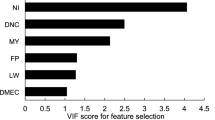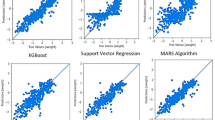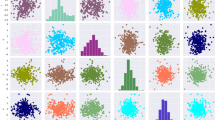Abstract
This study is concerned with developing predictive models using machine learning techniques to be used in identifying factors that influence farmers’ decisions, predict farmers’ decisions, and forecast farmers’ demands relating to breeding service. The data used to develop the models comes from a survey of small-scale dairy farmers from Tanzania (n = 3500 farmers), Kenya (n = 6190 farmers), Ethiopia (n = 4920 farmers), and Uganda (n = 5390 farmers) and more than 120 variables were identified to influence breeding decisions. Feature engineering process was used to reduce the number of variables to a practical level and to identify the most influential ones. Three algorithms were used for feature selection, namely: logistic regression, random forest, and Boruta. Subsequently, six predictive models, using features selected by feature selection method, were tested for each country—neural network, logistic regression, K-nearest neighbor, decision tree, random forest, and Gaussian mixture model. A combination of decision tree and random forest algorithms was used to develop the final models. Each country model showed high predictive power (up to 93%) and are ready for practical use. The use of ML techniques assisted in identifying the key factors that influence the adoption of breeding method that can be taken and prioritized to improve the dairy sector among countries. Moreover, it provided various alternatives for policymakers to compare the consequences of different courses of action which can assist in determining which alternative at any particular choice point had a high probability to succeed, given the information and alternatives pertinent to the breeding decision. Also, through the use of ML, results to the identification of different clusters of farmers, who were classified based on their farm, and farmers’ characteristics, i.e., farm location, feeding system, animal husbandry practices, etc. This information had significant value to decision-makers in finding the appropriate intervention for a particular cluster of farmers. In the future, such predictive models will assist decision-makers in planning and managing resources by allocating breeding services and capabilities where they would be most in demand.



Similar content being viewed by others
References
Anthony, M., Vincent, K., David, O., John, M., 2014. Breeding Services and the Factors Influencing Their Use on Smallholder Dairy Farms in Central Uganda. Vet. Med. Int. 2014.
Chandrashekar, G., Sahin, F., 2014. A survey on feature selection methods. Comput. Electr. Eng. 40, 16–28. https://doi.org/10.1016/J.COMPELECENG.2013.11.024
Dehinenet, G., Mekonnen, H., Kidoido, M., Ashenafi, M., Bleich, E.G., 2014. Factors influencing adoption of dairy technology on small holder dairy farmers in selected zones of Amhara and Oromia National Regional States, Ethiopia. Discourse J. Agric. Food Sci.
Fawcett, T., 2015. Mining the Quantified Self: Personal Knowledge Discovery as a Challenge for Data Science. Big Data 3, 249–266. https://doi.org/10.1089/big.2015.0049
Kikuhara, K., Kumagai, H., Hirooka H, 2009, Development and Evaluation of a Simulation Model for Dairy Cattle Production Systems Integrated with Forage Crop Production. Asian-Australasian J. Anim. Sci. 22, 57.
Lamb, G.C., Mercadante, V.R.G., Henry, D.D., Fontes, P.L.P., Dahlen, C.R., Larson, J.E., DiLorenzo, N., 2016. Invited Review: Advantages of current and future reproductive technologies for beef cattle production. Prof. Anim. Sci. 32, 162–171. https://doi.org/10.15232/PAS.2015-01455
León-Velarde, C., (CIP), R.Q.-P.C., 8pp, L.P., 2001, U., 2001. Modeling cattle production systems: integrating components and their interactions in the development of simulation models. Proceedings-Third Int. Symp. Syst. Approaches Agric. Dev. SAAD III Int. Potato Cent. (CIP), Lima Peru 8.
Lior, R., 2014. Data mining with decision trees: theory and applications.
Mohsen, H., El-Dahshan, E.-S.A., El-Horbaty, E.-S.M., Salem, A.-B.M., 2017. Classification using deep learning neural networks for brain tumors. Futur. Comput. Informatics J. https://doi.org/10.1016/J.FCIJ.2017.12.001
Mugisha, A., Kayiizi, V., Owiny, D., Mburu, J., 2014. Breeding services and the factors influencing their use on smallholder dairy farms in central Uganda. Vet. Med. Int. 2014, 169380. https://doi.org/10.1155/2014/169380
Murage, A.W., Ilatsia, E.D., 2011. Factors that determine use of breeding services by smallholder dairy farmers in Central Kenya. Trop Anim Heal. Prod 43, 43:199–207. https://doi.org/10.1007/s11250-010-9674-3
Mwanga, G., Mujibi, D., Yonah, Z., Chagunda, M., 2018a. Multi-country investigation of factors influencing breeding decisions by smallholder dairy farmers in sub-Saharan Africa. Trop. Anim. Health Prod. 51, 1–15. https://doi.org/10.1007/s11250-018-1703-7
Mwanga, G., Mujibi, D., Yonah, Z., Chagunda, M., 2018b. Predictive models for machine learning in smallholder dairy production systems.
Ristoski, P., Paulheim, H., 2016. Semantic Web in data mining and knowledge discovery: A comprehensive survey. Web Semant. Sci. Serv. Agents World Wide Web 36, 1–22. https://doi.org/10.1016/J.WEBSEM.2016.01.001
Schmidhuber, J., 2015. Deep learning in neural networks: An overview. Neural Networks 61, 85–117. https://doi.org/10.1016/j.neunet.2014.09.003
Scrucca, L., Fop, M., Murphy, B., Raftery, A., 2016. mclust 5: Clustering, Classification and Density Estimation Using Gaussian Finite Mixture Models. R J. 8, 289–317.
Shaikhina, T., Lowe, D., Daga, S., Briggs, D., Higgins, R., Khovanova, N., 2017. Decision tree and random forest models for outcome prediction in antibody incompatible kidney transplantation. Biomed. Signal Process. Control. https://doi.org/10.1016/J.BSPC.2017.01.012
Singh, A., Halgamuge, M.N., Lakshmiganthan, R., 2017. Impact of Different Data Types on Classifier Performance of Random Forest, Naïve Bayes, and K-Nearest Neighbors Algorithms. IJACSA) Int. J. Adv. Comput. Sci. Appl. 8.
Tefera, S., Lagat, J., Bett, H., 2014. Determinants of Artificial Insemination Use by Smallholder Dairy Farmers in Lemu-Bilbilo District, EthiopiaInt. J. African Asian Stud. 4.
Funding
The authors received the support of funding and data access provided by the Programme for Enhancing the Health and Productivity of Livestock (PEHPL, ID: OPP1083453) and Programme for Emerging Agricultural Research Leaders (PEARL).
Author information
Authors and Affiliations
Corresponding author
Ethics declarations
Ethical approval
All procedures performed in studies involving human participants were in accordance with the ethical standards of the institutional and/or national research committee and with the 1964 Helsinki declaration and its later amendments or comparable ethical standards.
Conflict of interest
The authors declare that they have no conflict of interest.
Additional information
Publisher’s note
Springer Nature remains neutral with regard to jurisdictional claims in published maps and institutional affiliations.
Electronic supplementary material
ESM 1
(PDF 2.33 mb)
Rights and permissions
About this article
Cite this article
Mwanga, G., Lockwood, S., Mujibi, D.F.N. et al. Machine learning models for predicting the use of different animal breeding services in smallholder dairy farms in Sub-Saharan Africa. Trop Anim Health Prod 52, 1081–1091 (2020). https://doi.org/10.1007/s11250-019-02097-5
Received:
Accepted:
Published:
Issue Date:
DOI: https://doi.org/10.1007/s11250-019-02097-5




